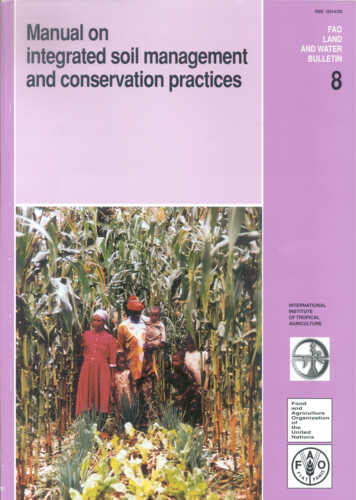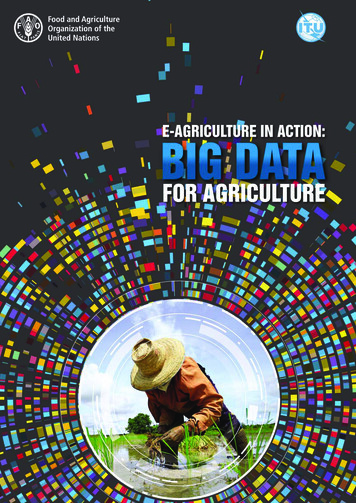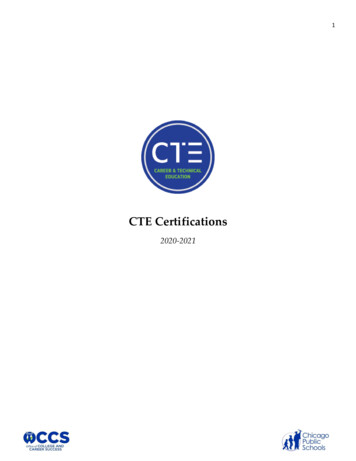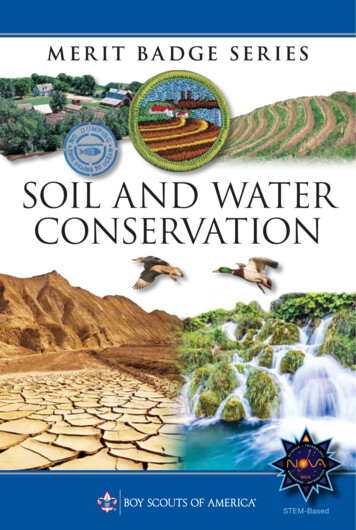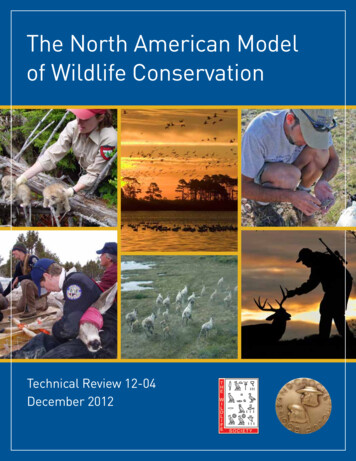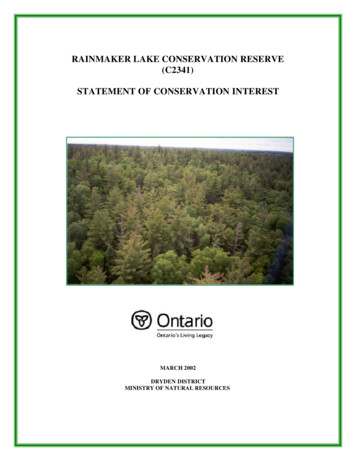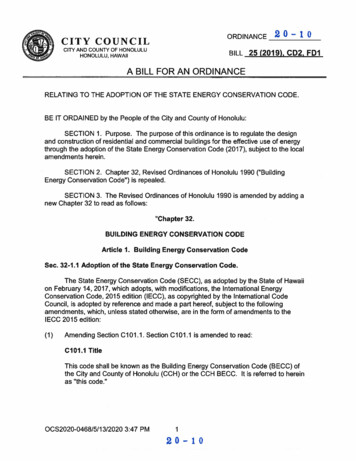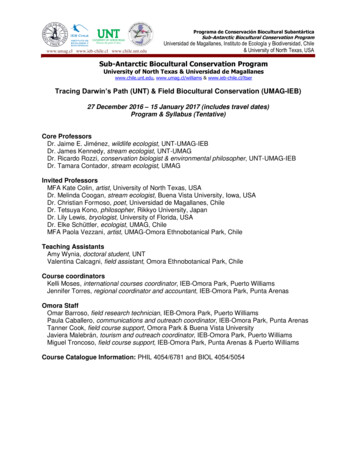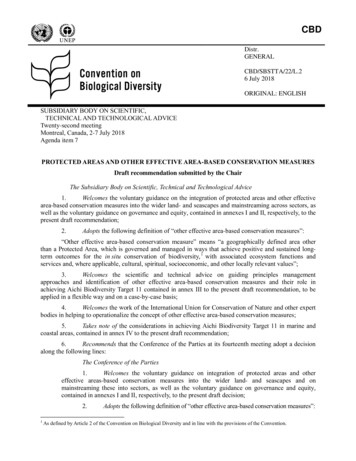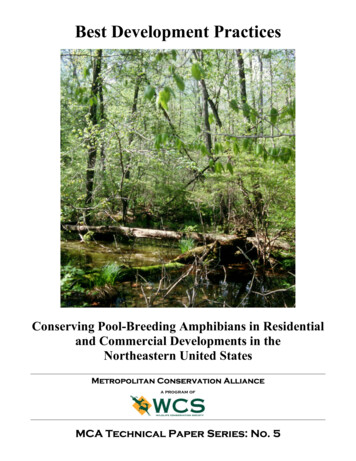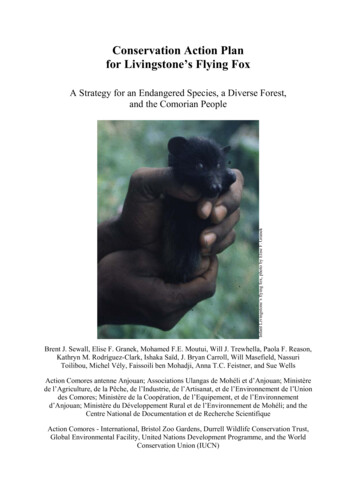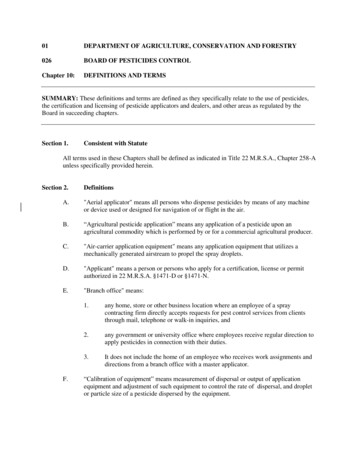
Transcription
01DEPARTMENT OF AGRICULTURE, CONSERVATION AND FORESTRY026BOARD OF PESTICIDES CONTROLChapter 10:DEFINITIONS AND TERMSSUMMARY: These definitions and terms are defined as they specifically relate to the use of pesticides,the certification and licensing of pesticide applicators and dealers, and other areas as regulated by theBoard in succeeding chapters.Section 1.Consistent with StatuteAll terms used in these Chapters shall be defined as indicated in Title 22 M.R.S.A., Chapter 258-Aunless specifically provided herein.Section 2.DefinitionsA."Aerial applicator" means all persons who dispense pesticides by means of any machineor device used or designed for navigation of or flight in the air.B.“Agricultural pesticide application” means any application of a pesticide upon anagricultural commodity which is performed by or for a commercial agricultural producer.C."Air-carrier application equipment" means any application equipment that utilizes amechanically generated airstream to propel the spray droplets.D."Applicant" means a person or persons who apply for a certification, license or permitauthorized in 22 M.R.S.A. §1471-D or §1471-N.E."Branch office" means:F.1.any home, store or other business location where an employee of a spraycontracting firm directly accepts requests for pest control services from clientsthrough mail, telephone or walk-in inquiries, and2.any government or university office where employees receive regular direction toapply pesticides in connection with their duties.3.It does not include the home of an employee who receives work assignments anddirections from a branch office with a master applicator.“Calibration of equipment” means measurement of dispersal or output of applicationequipment and adjustment of such equipment to control the rate of dispersal, and dropletor particle size of a pesticide dispersed by the equipment.
01-026 Chapter 10page 2G."Certification" means the recognition by the Board that an applicant has successfullyfulfilled all the appropriate competency criteria as set forth in these Chapters.H."Commercial agricultural producer" means, for the purposes of Chapter 50, any personwho produces an agricultural commodity for commercial purposes.I."Commercial applicator" means any person, unless exempted in I(4) hereunder, whetheror not the person is a private applicator with respect to some uses, who:1.Uses or supervises the use of any limited or restricted use pesticide other than asa private applicator; or2.Makes or supervises a custom application of a general use pesticide; or3.Applies a pesticide in connection with their duties as an official or an employeeof federal, state, county, university or local government.4.The following classes of applicators are exempt from commercialcertification/licensing requirements. Applications not listed below must beperformed under the direct on-site supervision of a licensed commercialapplicator Master and/or Operator.a.J.Persons applying ready-to-use general use pesticides by hand or withnon-powered equipment:i.to control stinging insects when there is an urgent need tomitigate or eliminate a pest that is a threat to health or safety; orii.to repel biting insects on patients and other persons under theircare or supervision who are unable to apply the material tothemselves; oriii.to repel biting insects on minors, such as students and campers,provided that a parent or legal guardian has authorized theapplication of insect repellents.b.Persons applying general use antimicrobial products by hand or withnon-powered equipment to interior or exterior surfaces and furnishingsof buildings during the course of routine cleaning procedures.c.Persons applying general use paints, stains or wood preservatives, exceptfor the treatment of standing utility poles.d.Persons installing hardware such as doorknobs and pushplates."Commercial applicator/Master" means a commercial applicator who, unless exempted inChapter 31, Section 1(Company/Agency Licensing Requirements), is responsible for themajor pest control decisions including, but not limited to, identifying unusual pests andchoosing the appropriate pest control strategies and techniques. This person is alsoresponsible for establishing policies relating to the operating practices of others applyingpesticides within the company or agency. Such practices may include equipment
01-026 Chapter 10page 3maintenance and calibration, employee training, safety and hygiene, pesticide andcontainer disposal, accident mitigation and ensuring that applications are conducted incompliance with all state and federal laws and regulations.K."Commercial applicator/Operator" means a commercial applicator who:1.applies or directs the application of a pesticide according to the instructions ofthe master when a master is required according to Chapter 31, Section 1(Company /Agency Licensing Requirements); or2.applies or directs the application of a pesticide and performs the function of themaster applicator when a separate master is not required according to Chapter 31,Section 1(Company/Agency Licensing Requirements).L."Compact urban line" means that delineation made by the Maine Department ofTransportation which denotes a section of the highway where structures are nearer than200 feet apart for a distance of one-quarter of a mile.M.Compatibility” means that property of a pesticide that permits its use with otherchemicals without undesirable results being caused by the combination.N.“Competent” means properly qualified to perform functions associated with pesticideapplication, the degree of capability required being directly related to the nature of theactivity and the associated responsibility.O.“Common exposure route” means a likely way (oral, dermal, respiratory) by which apesticide may reach and/or enter an organism.P."Custom application" means an application of a pesticide:1.Under contract or for which compensation is received;a.For the purposes of this definition, "under contract" includes: verbal orwritten agreements to provide services which include the use of anypesticide; i.e., private or commercial rental agreements, pest controlservice agreements, landscape maintenance agreements, etc.b.For purposes of this definition, compensation is deemed to have beenreceived for a pesticide application where any form of remuneration hasbeen or will be exchanged, including payment of cash, rent, or otherfinancial consideration, or by the exchange of goods and/or services.This also includes any agreements where crops grown on rented land willbe sold to the landowner or are otherwise grown for the benefit of theland owner.
01-026 Chapter 102.3.page 4To a property open to use by the public;a.For purposes of this definition, property is deemed to be open to use by thepublic where its owner, lessee or other lawful occupant operates, maintainsor holds the property open or allows access for routine use by members ofthe public. Persons are considered to be members of the public even thoughthey may pay a fee or other compensation in order to make use of theproperty or may visit the property for a commercial purpose.b.Property open to use by the public includes but is not limited to: shoppingcenters, office and store space routinely open to the public (i.e. rest rooms,self-service areas and display aisles), common areas of apartmentbuildings, occupied apartments, public pools and water parks, schools andother institutional buildings, public roads, organized recreational facilities,golf courses, campgrounds, parks, parking lots, ornamental and turf areasaround condominiums, apartment buildings, stores malls and retail areasof greenhouses and nurseries if the public is allowed access before thepesticide restricted-entry or re-entry interval elapses.c.Examples of property not open to use by the public include withoutlimitation: farms, forest lands, and private residential or commercialproperty which is not routinely operated or maintained for use by thepublic or otherwise held open to public use.d.Notwithstanding this definition, property shall not be deemed to be openfor use by the public in the following cases:i.where the property is devoted primarily to agricultural, forest,ornamental tree or plant production, but this exception shall notapply to campgrounds, leased inholdings or roads within suchproperty which are open for use by the public;ii.where the public has not been permitted upon the property at anytime within seven days of when the property received a pesticideapplication;iii.forestry rights of way where the property has been closed duringthe time of spraying or during the label restricted entry intervalor re-entry period, whichever is greater.Ivwhere the public has not been permitted on the treated portion ofprivately held recreational land within seven days of a pesticideapplication for vegetation management.In a food establishment licensed under M.R.S. 22, Chapter 551, or an eatingestablishment licensed under M.R.S. 22, Chapter 562, except that “customapplication” does not include a pesticide application at a licensed food or eatingestablishment when:a.The establishment is ancillary to the production of an agriculturalcommodity;
01-026 Chapter 104.page 5b.The owner or an employee of that establishment is certified as a privateapplicator under section 1471-C, subsection 2; andc.The property is not open to the public.A pesticide application shall not be deemed a custom application where it isundertaken by a licensed private applicator on property owned or rented by himor his employer or in trade for personal agricultural services between producersof agricultural commodities.Q."Distribute" means to offer for sale, hold for sale, sell, barter, ship, deliver for shipmentor receive and, having so received, deliver or offer to deliver pesticides in this state. Thisalso means giving free samples of unregistered products to any person. Sales ofhardware, such as doorknobs and pushplates, shall not be considered distribution for thepurposes of this definition.R“Environment” means water, air, land, and all plants and man and other animals livingtherein, and the interrelationships that exist among them.S."Forest" means a concentration of trees and related vegetation managed primarily for theproduction of forest agricultural commodities such as timber, fiber or other woodproducts, including other similar areas managed for recreation or resource conservation.T.For the purposes of 22 M.R.S. §1471-D (9), “Government Employee” means a personwho is employed full- or part-time as a regular employee of any governmental or quasigovernmental organization including federal, state, county and municipal governmentsand public universities.U.“Hazard” means a probability that a given pesticide will have an adverse effect on man orthe environment in a given situation, the relative likelihood of danger or ill effect beingdependent on a number of interrelated factors present at any given time.V.“Host” means any plant or animal on or in which another lives for nourishment,development, or protection.W."Integrated Pest Management" (IPM) means the selection, integration andimplementation of pest damage prevention and control based on predicted socioeconomicand ecological consequences, including: (1) understanding the system in which the pestexists, (2) establishing dynamic economic or aesthetic injury thresholds and determiningwhether the organism or organism complex warrants control, (3) monitoring pests andnatural enemies, (4) when needed, selecting the appropriate system of cultural,mechanical, genetic, including resistant cultivars, biological or chemical preventiontechniques or controls for desired suppression, and (5) systematically evaluating the pestmanagement approaches utilized.X."Integrated Pest Management Coordinator" means the lead person in a school system orschool who is knowledgeable about integrated pest management and is designated byeach school to implement the school pest management policy.
01-026 Chapter 10page 6Y."License" means a commercial applicator license, a private applicator certification, adealer license, a permit to chemically control vertebrate animals, or a permit to applylimited use pesticides.Z."Licensing" means the issuance by the Board of a document signifying that the applicanthas been certified and has met all applicable employee, fee, insurance and reportingrequirements.AA."Major application project" means any pesticide application contract that requires theapplicator to apply pesticides to more than 1000 acres in the aggregate within a givenyear. This does not include repeat applications to the same site.BB."Major pesticide storage facility" means any fixed-site, totally enclosed building orportion of such building owned and/or operated by a pesticide distributor wherepesticides are held in storage and which meets one of the following criteria:CC.1.contains at any one time an amount greater than or equal to 6,000 pounds of drypesticide product, other than dry formulations of products listed in Chapter 24,Section 2, "Exempted Products," or2.contains at any one time an amount greater than or equal to 600 gallons of liquidpesticide product, other than liquid formulations of products listed in Chapter 24,Section 2, "Exempted Products," or3.contains liquid pesticides in containers that are thirty (30) gallons or greater insize, other than liquid formulations of products listed in Chapter 24, Section 2,"Exempted Products.""Minor pesticide storage facility" means any fixed-site, totally enclosed building orportion of such building owned and/or operated by a pesticide distributor wherepesticides are held in storage and which meets one of the following criteria:1.contains at any one time an amount greater than 100 pounds but less than 6,000pounds of dry pesticide product, other than dry formulations of products listed inChapter 24, Section 2, "Exempted Products," or2.contains at any one time an amount greater than 50 gallons but less than 600gallons of liquid pesticide, other than liquid formulations of products listed inChapter 24, Section 2, "Exempted Products," or3.contains liquid pesticides in containers greater than three (3) gallons but less thanthirty (30) gallons in size, other than liquid formulations of products listed inChapter 24, Section 2, "Exempted Products."DD.“Non-agricultural pesticide application” means any application of a pesticide that is notan agricultural pesticide application.EE."Non-powered equipment" means pesticide spray equipment which pumps and dispersespesticides without utilization of an electric, gasoline, wind-driven or other motorizedpower source. By way of example, non-powered equipment includes manual pump spray
01-026 Chapter 10page 7equipment and self-contained aerosol spray cans or bottles but does not includeequipment which employs a motor, except one powered only by hand.FF.“Non-target organism” means a plant or animal other than the one against which thepesticide is applied.GG."Off-target direct discharge of pesticides" means the direct application of pesticides ontoproperty beyond the boundaries of the target area intended to be treated. Presence ofoff-target direct discharge of pesticides may be determined by any evidence, throughobservation, residue samples or other techniques, that an off-target area has receivedsubstantially the same dose of pesticide as a target area.HH."Off-target drift of pesticides" means the drifting of pesticides by air currents or diffusionwith resulting deposition of pesticides onto property beyond the boundaries of the targetarea intended to be treated. The detection of pesticides beyond the boundaries of thetarget area intended to be treated shall be presumed to be as a result of off-target driftunless there is evidence of off-target direct discharge of pesticides.II."Ornamental plant" means shrubs, trees and related vegetation in and around habitationgenerally, but not necessarily, located in urban and suburban areas, including residences,parks, streets, retail outlets, and industrial and institutional buildings.JJ."Other forest pests" means forest pests, other than insects and include, but are not limitedto, weeds, mites, nematodes, fungi, bacteria, and viruses.KK."Owner" means sole proprietor, partner or stockholder.LL."Person" means any individual, partnership, fiduciary, corporation, governmental entity,association or public or private organization of any character, other than the Board.MM."Pesticide" means any substance or mixture of substances intended for preventing,destroying, repelling or mitigating any pest; any substance or mixture of substancesintended for use as a plant regulator, defoliant or desiccant; and any nitrogen stabilizer.It does not include multicellular biological controls such as mites, nematodes, parasiticwasps, snails or other biological agents not regulated as pesticides by the U.S.Environmental Protection Agency.NN."Pesticide dealer" means any person who distributes limited or restricted-use pesticides,including but not limited to sales personnel in an outlet, field salesmen, andmanufacturers' representatives selling pesticides directly to the consumer or who acceptorders for pesticides.OO."Pesticide distributor" means any person required to be licensed to distribute general,restricted or limited use pesticides.PP."Pesticide storage facility" means any fixed-site, totally enclosed building or portion ofsuch building where pesticides are held for storage.QQ.“Practical knowledge” means the possession of pertinent facts and comprehensiontogether with the ability to use them in dealing with specific problems and situations.
01-026 Chapter 10page 8RR.“Principal place of business” means the principal location, either residence or office, inthe State in which an individual, partnership, or corporation applies pesticides.SS."Private Applicator" means any person who uses or supervises the use of any pesticidewhich is classified for restricted or limited use for purposes of producing any agriculturalcommodity on property owned or rented by him or his employer or, if applied withoutcompensation other than the trading of personal services between producers ofagricultural commodities, on the property of another person. In situations where theapplicator is applying pesticides to crops on rented land, there must be a written contractshowing that the grower/applicator retains control over the property as well as thedisposition or sale of the harvested crop.TT."Private domestic well" means any well used for drinking water other than one whichserves a public water system.UU."Project" means, for the purposes of Chapter 51, the aerial application of pesticides tocontrol an individual forest insect pest complex provided by:1.Any number of applicator businesses for a single person, or2.One applicator business on contiguous parcels of land.VV.“Public precautions" means those statements which appear on the pesticide label directedtowards the non-applicator public. Public precautions may include, but are not limited to,re-entry intervals.WW."Public water system" means any water supply system that provides water to at least 15service connections or serves water to at least 25 individuals daily for at least 30 days a year.XX.“Regulated pest” means a specific organism considered by a State or Federal agency tobe a pest requiring regulatory restrictions, regulations, or control procedures in order toprotect the host, man and/or his environment.YY."School" means any public or private elementary or secondary school, kindergarten ornursery school that is part of an elementary or secondary school or a tribally funded school.ZZ."School Building" means any structure used or occupied by students or staff of any school.AAA. "School Grounds" means:BBB.1.land associated with a school building including playgrounds, athletic fields andagricultural fields used by students or staff of a school, and2.any other outdoor area used by students or staff that is under the control of a school."Self-service sales area" means any area within or immediately outside a retail orwholesale business in which members of the public have direct access to pesticideproducts. For the purposes of this chapter, self-service sales areas shall be limited to thosepesticide products which require a pesticide dealer to be licensed under 22 M.R.S.A.§1471-W, "General Use Pesticide Dealers."
01-026 Chapter 10CCC.page 9"Sensitive area" means any of the following, except where the area involved is theintended target of the pesticide application:1.Apiaries, the location of which is registered with the Department ofAgriculture, Conservation and Forestry pursuant to 7 M.R.S.A.§2701;2.Critical areas designated by the Board pursuant to 22 M.R.S.A. §1471-M(2);3.Public wells, drinking water springs used by the public, and public water supplyintake points, provided the location of the same is known or should reasonably beknown to the pesticide applicator;4.Private sources of drinking water, where the owner or legal user thereof hasgiven prior notice of the location of such source to the landowner or lessee of thearea which will be subject to a pesticide application;5.Water bodies, including streams, brooks, rivers, ponds, lakes, estuaries andmarine waters, provided that any such water body contains water at the time ofthe pesticide application and is known to the spray applicator or is reasonablydetectable from visual observation, reasonably available maps or reasonableinquiry. This term shall not include: (a) in the case of forest aerial sprayprograms, streams and brooks that are neither shown on reasonably availablemaps nor visible from an aircraft operating at 1000 feet in elevation aboveground level; and (b) waters that are confined and retained completely upon theproperty of the person conducting or contracting for spray services, and that donot drain into or connect with any other water body;6.Wetlands of Special Significance.7.Cleared areas where livestock are contained or pastured, cultivated land, croplandor gardens.8.A “Sensitive Area Likely to Be Occupied” is an area where humans are likely tobe present including the following:a.Residential buildings, together with any associated maintained areaslikely to be occupied by humans, such as lawns, gardens, recreationalareas and livestock management and housing areas;b.School buildings, together with any associated maintained areas that areareas likely to be occupied by humans, such as playgrounds, athleticfields or courts;c.Commercial, institutional, or other structures likely to be occupied byhumans, together with any associated maintained areas such as lawns,gardens, parking and recreational areas;d.Maintained recreational areas likely to be occupied by humans includingcampgrounds, picnic areas, marked roadside rest areas, marked hikingtrails, park and recreation facilities, athletic fields, and other areas fororganized sports or recreation. This definition does not include trails
01-026 Chapter 10page 10located on privately owned lands which are used by permission of thelandowner.DDD. "Spray application" means, for the purposes of Chapter 51, the dispensing of pesticides inany manner from an aircraft.EEE.FFF."Spray contracting firm" means any person, including a corporation, employed orcontracted to conduct a public or private custom application of one or more pesticides.This term does not include:1.the owner or lessee of land to be sprayed and employees of that landowner orlessee,2.the Division of Forestry and the employees of the Division of Forestry,3.individuals who are certified as commercial applicators providing that individualdoes not have in his/her employment one or more others to undertake pesticideapplications; or4.persons who perform custom applications of pesticides solely on or within apremises which they own or lease.5.persons and corporations that subcontract for pesticide applications, but do notmaintain any control over the pesticide application including which pesticides areapplied, when they are applied or how they are applied."Spray period report" means a written description of the spray activity certifying he date andtime, the area usually sprayed, the pesticide used, and including a description of the weatherconditions during spray activity. The report must also include a map showing where spraybooms were turned on and off, with notation of any non-target areas that were sprayed.GGG. “Standard” means the measure of knowledge and ability that must be demonstrated as arequirement for certification.HHH. "Storage" means holding pesticides for distribution in locations other than self-servicesales areas.III.“Susceptibility” means the degree to which an organism is affected by a pesticide at aparticular level of exposure.JJJ.“Toxicity” means the property of a pesticide to cause any adverse physiological effects.KKK. “Uncertified person” means any person who is not holding a currently valid certificationdocument indicating that he is certified under section 4 of FIFRA in the category of therestricted use pesticide made available for use.LLL."Wetlands of Special Significance" means all coastal wetlands and great ponds. Inaddition, certain freshwater wetlands are considered wetlands of special significance ifthey have one or more of the following characteristics.
01-026 Chapter 10page 111.Critically imperiled or imperiled community. The freshwater wetland containsa natural community that is critically imperiled (S1) or imperiled (S2) as definedby the Natural Areas Program.2.Significant wildlife habitat. The freshwater wetland contains significant wildlifehabitat as defined by 38 M.R.S.A. §480-B(10).3.Location near coastal wetland. The freshwater wetland area is located within250 feet of a coastal wetland.4.Location near GPA great pond. The freshwater wetland area is located within250 feet of the normal high water line, and within the same watershed, of anylake or pond classified as GPA under 38 M.R.S.A. §465-A.5.Aquatic vegetation, emergent marsh vegetation or open water. Thefreshwater wetland contains under normal circumstances at least 20,000 squarefeet of aquatic vegetation, emergent marsh vegetation or open water, unless the20,000 or more square foot area is the result of an artificial ponds orimpoundment.6.Wetlands subject to flooding. The freshwater wetland area is inundated withfloodwater during a 100-year flood event based on flood insurance mapsproduced by the Federal Emergency Management Agency or other site-specificinformation.7.Peatlands. The freshwater wetland is or contains peatlands, except that theDepartment of Environmental Protection may determine that a previously minedpeatland, or portion thereof, is not a wetland of special significance.8.River, stream or brook. The freshwater wetland area is located within 25 feet ofa river, stream or brook.
01-026 Chapter 10page 12STATUTORY AUTHORITY: 22 M.R.S.A., Chapter 258-AEFFECTIVE DATE:July 6, 1979AMENDED:April 27, 1988May 21, 1996August 17, 1996October 2, 1996EFFECTIVE DATE (ELECTRONIC CONVERSION):March 1, 1997AMENDED:April 14, 1998 - inserted definitions for “Agricultural pesticide application” and “Non-agriculturalpesticide application”; renumbered; converted to MS Word.March 5, 2003NON-SUBSTANTIVE CORRECTION:February 17, 2004 - cross reference in Section 2.HAMENDED:January 4, 2005 – filing 2004-602March 4, 2007 – Section 2(I)(4)(c), filing 2007-64July 16, 2009 – filing 2009-251 (major substantive final adoption)January 29, 2013 – filing 2013-014CORRECTIONS:February, 2014 – agency names, formattingAMENDED:July 23, 2019 – Section 2(A), (P)(2)(d), filing 2019-130
01DEPARTMENT OF AGRICULTURE, CONSERVATION AND FORESTRY026BOARD OF PESTICIDES CONTROLChapter 20:SPECIAL PROVISIONSSUMMARY: These provisions regulate the use, storage and disposal of pesticides with specific emphasison registered pesticides, right of way and aquatic applications and employer/employee requirements.Section 1.Registered PesticidesA.The use of any pesticide not registered by the Maine Board of Pesticides Control inaccordance with Title 7 M.R.S.A. §601 is prohibited except as otherwise provided in thischapter or by FIFRA, Section 2(ee).B.The use of registered pesticides for other than registered uses, or at greater than registereddosages, or at more frequent than registered intervals is prohibited, provided thatapplication or use of unregistered pesticides and unregistered applications or uses ofregistered pesticides may be made for experimental purposes if in accordance withrequirements of the Maine Board of Pesticides Control, and the U.S. EnvironmentalProtection Agency.C.Retailers and end users of pesticides no longer registered in Maine may continue to selland use those items provided they were properly registered when obtained and suchdistribution and use is not prohibited by FIFRA or other Federal law.D.In conducting review of registration or re-registration pursuant to 7 M.R.S.A. §607-A, theBoard may consider the potential for environmental damage by the pesticide throughdirect application on or off-target or by reason of drift. If the Board finds that the use ofthe pesticide is anticipated to result in significant adverse impacts on the environment,whether on or off-target, which cannot be avoided or adequately mitigated, registration orre-registration will not be granted unless the Board finds that anticipated benefits ofregistration clearly outweigh the risks. In any case where the Board may request data inconnection with registration or re-registration of any pesticide, such data may include thatconcerning pesticide residues, propensity for drift and testing therefor. Such data, ifrequested, shall provide information regarding residues and residue effects on planttissues, soil and water and other potential deposition sites, and shall take intoconsideration differences in plants, soils, climatic conditions at the time of applicationand application te
written agreements to provide services which include the use of any pesticide; i.e., private or commercial rental agreements, pest control service agreements, landscape maintenance agreements, etc. b. For purposes of this definition, compensation is deemed to have been received for a pesticide application where any form of remuneration has
